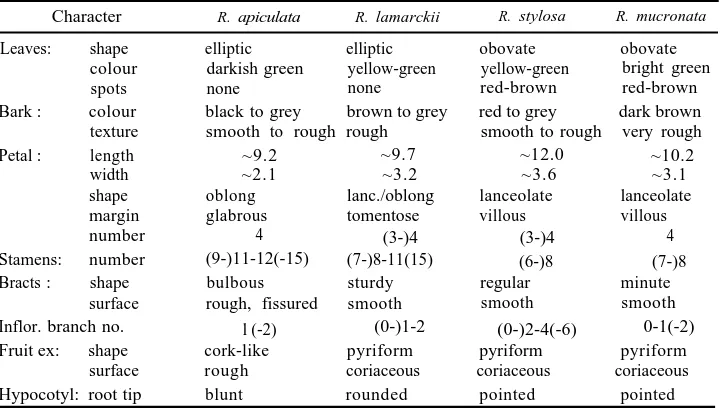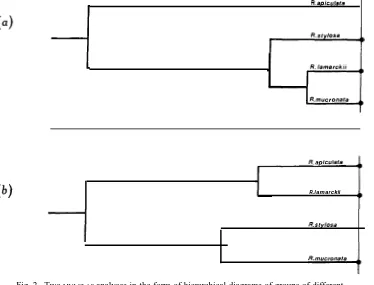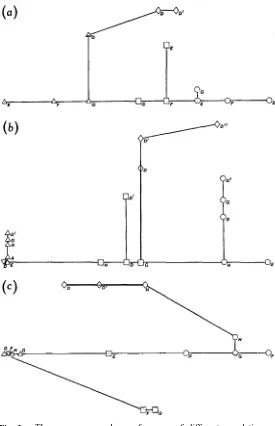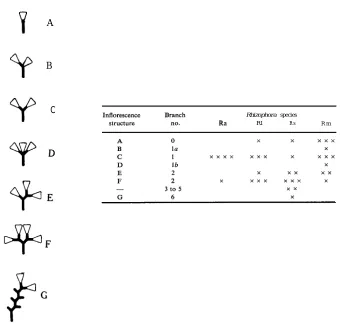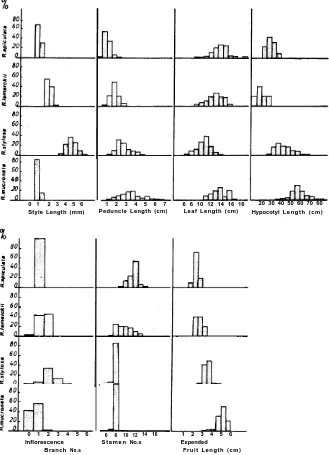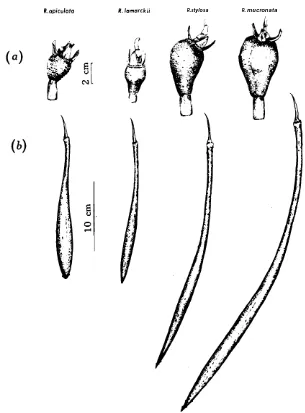Aust. J. Bot., 1979, 27, 657-78
The Genus Rhizophora (Rhizophoraceae)
in North-eastern Australia
N. C. Duke and J. S. Bunt
Australian Institute of Marine Science, P.M.B. 3, M.S.O., Townsville, Qld 4810.
Abstract
Recent global revisions have failed to resolve difficulties in identification of the AustralianRhizophora.
Presented is a field key and detailed specific descriptions of the four species found in the north-east. Classificatory analyses revealed the distinct nature of the entities and some of their associations with each other.
Introduction
Salvoza (1936) and more recently Ding Hou (1958, 1960) have reviewed the genus
Rhizophorain global terms. Unfortunately their work was based on poorly repre-sentative herbarium material. Consequently, regional inadequacies persist. This is the case in north-eastern Queensland. Thus, an important and well-used field key developed for the Australian east coast mangroves (Jones 1971) omits a major species,
R. Zamarckii, now recognized from our observations by Tomlinson and Womersley (1976). Even the most recent revisions, referring specifically to the Indo-Malesian and Australian species, suffer to some extent from limited field observations. Although
R. mucronatahas been noted in this region (Ding Hou 1960; Jones 1971; Tomlinson 1978) it appears to have been missed from the detailed treatments correlating herbarium revisions and field observations. The problem in Australia is due to the lack of adequate information on phenological variation, especially relating to the definitive characters which may prove unique to this region. We consider that the most recent key by Tomlinson (1978) although of great value on a global scale, does not adequately cover the Australian species. Differences in characters such as bud colour and length, leaf length, inflorescence structure, stamen number, style length and peduncle length are all significant. The existence of these differences is felt by the authors to justify the development of a key to the north-eastern Australian Rhizophora.
Mangrove productivity studies currently in progress on the Australian north-east coast have provided opportunities for, and indeed required, reliable species identifica-tion. The study reported here provides detailed comparative information for the north-eastern Australian Rhizophoraand a field key to the four species now known to occur in this region.
658 N. C. Duke and J. S. Bunt
Methods
Study Area
Sites from the Torres Strait (the strait between Australia and New Guinea) islands to Port Clinton (Table 1 and Fig. 1), have been visited over the past 2 years. Fast rubber inflatable boats have enabled most of the tidal reaches of rivers, estuaries and bays to be covered efficiently. Aerial photography permitted precise navigation and
the initial identification of the tidal forests. Sites between the Daintree River and
Cape York were selected in terms of their distribution and on obvious physiographic differences, in the hope of sampling the range of tidal forest situations in the region. Areas south of the Daintree to the southern end of Hinchinbrook Island have been studied with greater intensity partly because of the environmental diversity evident but also because of their closer proximity to Hinchinbrook Island, which was the main study area. Sites south to Port Clinton have been given only casual attention. All four species can be located conveniently within single rivers (e.g. Hull River) along the coastal strip close to Hinchinbrook Island.
Observations and Measurements
The characters of the Rhizophora species are very similar (Table 4 and Fig. 5), so that species can be easily confused when direct distinctions are made through measurements of phenotypic detail if the definitive characters are not present (or are missed). Paradoxically, however, it was established that, with practice, the Rhizophora species could be reliably distinguished from a distance on tree foliage and habit. Thus less definitive factors seem to combine to give a specific character to trees of each species. To make use of these less definitive characters and to validate the field observations, a classificatory analysis was attempted on trees of a known species (identified with the definitive characters as described later). A range of reproductive and vegetative characters from a selection of sites were measured. The primary outcome of the analyses was that individual species clearly showed up consistently. In addition, species relationships and some interspecific character affinities were shown. Populations of Rhizophora have been observed at all sites listed in Table 1. Com-prehensive samples were taken at eight of the locations visited including four on Hinchinbrook Island, namely Coral Creek, Wide Creek, Bowen Creek and Deluge Inlet; and one each at Shallow Bay, Jacky Jacky Creek, Claudie River and Hull River (Fig. 1). Advice from P. B. Tomlinson in 1975 initiated this study through measurement of at least four characters of the flower parts (i.e. 9, 10, 12 and 13 in Table 2) from the majority of the site samples. Later it was decided to expand the study by measuring the dimensions of the mature hypocotyl* and expended fruit† (i.e. 15, 16 and 18-22 in Table 2). The number of phenological measurements in the field was increased to 18, not including the calculation of significant ratios. The selected characters with brief descriptions are listed in Table 2, and the sites sampled in Table 3. For practical reasons, it was not possible to obtain complete data sets from all locations visited. Identification was achieved initially by comparison with the available keys as well as through direct consultation with P. B. Tomlinson, and
* Hypocotyls were taken as being mature when the propagules could be dislodged by a gentle shaking
of the branch on which they were attached.
Genus Rhizophorain North-eastern Australia 659
finally by consideration of certain more or less definitive characters selected on the
basis of experience. All18 characters have been drawn upon in this study. For each
GRIEAT BARRIER REEF
QUEENSLAND
.:
Fig. 1. Map of the locations visited during the course of the study.
[image:3.453.69.413.108.594.2]660 N. C. Duke and J. S. Bunt
Table 1. Locations visited (Fig. 1) , with latitudes, in the study are and Rhizophora species found
Observations of each species are listed as present (P), no sighting (A), and no sighting but low numbers expected (?); C, phenological measurements taken; S, herbarium voucher specimens held at AIMS.
Gross annual mean (30 years) rainfall (Mumme 1969) shown roughly as: L (up to 1900mm), M (1901-2900 mm), and H (2901 mm and higher)
Location Lat.
(S.)
Rainfall Rhizophora speciesA Ra Rl Rs Rm
Jardine River 10º 55' L P ? P P Cowal Creek 10º 54' M P P,S P P,S
Wednesday Island 10° 31' L P A P A
Tuesday Island 10º 30' L A A P A Barnia Creek 10° 43’ M P,C P P P,S Jacky Jacky Creek 10º 52' L P,C P,C,S P,C A Escape River 10º 59’ L P P P A Harmer Creek 11° 55' L P P P P Round Point (creek) 11° 54' L P ? P A
Macmillan River 11° 55' L P P P A
Sir Charles Hardy I. 11° 55' L A A P A Olive River 12º 10' M P P,S P P
Piper Island 12º 15’ M A A P A
Kangaroo River 12º 22' L P,S P P A
Pascoe River 12º 31' M P ? P,S P
Claudie River 12º 50' M P,C P P,C P,C
Lockhart River 12º 52' L P,S P P P
Nesbit River 13º 33’ L P A P A Rocky River 13º 48' L P ? P A Stewart River 14º 04' L P ? P A
Cliff Island (east) 14º 13' L A A P A
Annie River 14º 29' L A A P A
Normanby River 14º 25' L A A P A
Stanley Island 14º 09’ L A A P A
Flinders Island 14º 11’ L P P,S P A
Jeanie River 14º 40' L A A P A
McIvor/Morgan River 15º ll' L P P P P
Endeavour River 15º 28' L P P P P
Annan River 15º 31’ M ? ? P P Bloomfield River 15º 55' M P ? P P Coopers Creek 16º 10' M P P,S P,S P,S
Daintree River 16º 16' M P,S P P,S P,S
Port Douglas 16º 28' M P ? P A
Trinity Inlet 16º 55' M P P P P
Mulgrave River 17º 14’ H P ? P P Russel River 17º 14' H P ? P P Johnstone River 17º 31’ H P ? P P Moresby River 17º 36' M P P P P
Hull River 17º 59' M P,C,S P,C,S P,C,S P,C,S
Tully River 18º 02' H P ? P P,S Murray River 18º 05' M P ? P P Hinchinbrook Channel 18º 15'- 31' M P,S P,S P A
Missionary Bay 18º l5' M P,C,S P,C,S P,C,S A
Zoe Bay 18º 23' M P P P,S A
Deluge Inlet 18º 25' M P,C P,C,S P,C,S P,C,S
GenusRhizophora in North-eastern Australia 661
Table 1 (Continued)
Location Lat. Rainfall Rhizophora speciesA
(S.) Ra Rl Rs Rm
Crocodile Creek 19º l7' L A A P A
Cape Ferguson 19º 17' L P,S A P,S A
Repulse Bay 20º 27’ M P P P A
Mackay 21º 18' L P ? P A
Sarina 21° 24' M P ? P A
Port Clinton 22º 30' L P P,S P A
[image:5.451.96.381.241.491.2]A Ra, apiculata; Rl, lamarckii; Rs, stylosa; Rm, mucronata.
Table 2. Characters used for classificatory analyses and specific descriptions
Summation of character groups as noted in the text: leaf characters (1-5); characters of buds and flowers (6-14); characters of expended fruit and
hypocotyls (15-23)
Character Description
1 Leaf L 2 Leaf W 3 Leaf L/W 4 Petiole L 5 Leaf mucro L 6 Bud L 7 Bud W 8 Bud L/W 9 Peduncle L 10 Peduncle W 11 Peduncle L/W
12 Inflorescence branch N 13 Stamen N
14 Style L
15 Expended (ex) fruit L 16 Expended fruit W 17 Expended fruit L/W 18 Expended fruit peduncle L 19 Expended fruit peduncle W 20 Hypocotyl L
21 Hypocotyl collar W 22 Hypocotyl W 23 Hypocotyl L/W
Blade length Widest width
Leaf (length/width) ratio Overall straight length Mature intact length
Mature, bract base to tip, length Widest width
Bud (length/width) ratio Overall straight length Mid section, width
Peduncle (length/width) ratio Dichotomous branch points Number of developed stamens Length, ovary base to tip Calyx lobe base to tip, length Widest width
Expended fruit (length/width) ratio Overall straight length
Mid section, width Shoot to root tip, length Rim diameter at shoot base Widest width
Hypocotyl (length/width) ratio
Table 3. Sites of collection for classificatory analyses and specific descriptions
Site locations A Barnia Creek, Shallow Bay B Jacky Jacky Creek C Claudie River
D Hull River
[image:5.451.158.320.528.629.2]662 N. C. Duke and J. S. Bunt
Classificatory Analysis
Observation of the variation of any particular character in Rhizophora, such as
[image:6.451.30.393.191.545.2]peduncle length, shows that there is quite often overlap between species. Thus these characters can be described as non-definitive. Simultaneous evaluation of a number of these characters is necessary to group populations according to species. Data obtained from the phenological measurements of several populations were subjected to classificatory techniques (Gower and Ross 1969; Williams 1971).
Table 4. Mean measurements (cm) for Rhizophora species, with {range} and [number of components measured]
Character R. apiculata R. lamarckii R. stylosa R. mucronata
Leaf L 13·04 [107] 11.36 [80] 9.98 [l00] 13.25 [40]
{7·9-19·0} {7·7-14·8} {6.3-13.7} {10.5-16.5}
Leaf W 6.48 [107] 5.81 [80] 5.78 [l00] 7.39 [40]
{3.9-8.8} {3.2-8.2} {3.8-8.0} {5.1-10.6}
Petiole L 2.45 [107] 2.48 [80] 2.37 [l00] 3.11 [40]
{l.l-3.9} {1.2-3.5} {1.3-3.6} {2.2-4.1} Leaf mucro L 0.37 [l00] 0.44 [70] 0.37 [l00] 0.36 [33] {0.2-0.6} {0.3-0.6} {0.2-0.6} {0.2-0.5}
Stipule LA 6.98 [29] 5.99 [35] 4.57 [49] 6.76 [13]
{4.6-8.5} {3.7-8.4} {2.6-6.4} {5.8-7.9}
Bud L 1.37 [l00] 1.48 [70] 1.52 [102] 1.50 [33]
{l.l-1.6} {l.l-1.7} {1.3-1.8} {1.2-1.8}
Bud W 1.04 [l00] 0.96 [70] 0.78 [102] 0.79 [33]
{l.0-1.3} {0.7-1.2} {0.7-0.9} {0.7- 1.0}
Style L 0.09 [106] 0.19 [75] 0.42 [114] 0.11 [44]
{0.05-0.l} {0.l-0.3} {0.3-0.55} {0.06-0.2}
Peduncle L 0.97 [307] 1.78 [130] 2.73 [365] 3.45 [229]
{0.3-2.1} {0.8-3.0} {1.2-4.8} {1.2-6.6}
Peduncle W 0.51 [307] 0.42 [130] 0.30 [365] 0.32 [229]
{0.4-0.7} {0.3-0.5} {0.2-0.4} {0.2-0.5}
Fruit ex L 2.24 [104] 2.61 [4] 3.52 [114] 5.10 [85]
{1.8-2.7} {2.4-3.0} {2.7-4.8} {3.4-6.0}
Fruit ex W 2.06 [104] 1.93 [4] 2.67 [114] 3.16 [85]
{1.7-2.4} {1.8-2.1} {2.1-3.2} {1.9-3.7}
Hypocotyl L 28.2 [104] 18.7 [4] 42.0 [116] 58.7 [79]
{20-37} {14-28} {26-65} {40-80}
Hypocotyl W 1.68 [104] 1.20 [4] 1.58 [116] 1.69 [79]
{1.2-2.0} {l.0-1.3} {1.2-2.1} {1.2-2.1}
Collar W 0.80 [104] 0.73 [4] 1.07 [116] 1.02 [79]
{0.6-0.9} {0.6-0.9} {0.8-1.4} {0.8-1.2} A Stipule L: interpetiolar stipule (or leaf sheath) length. This character was not used in the analysis.
Populations of the species were classified from several groups of data by using the Euclidean analysis of Burr (1968, 1970). The attributes were standardized to bring them to equal variance, then the metric was used as a distance measure and sorted
to minimize the incremental sum of squares. The matrix of the distances was also
Genus Rhizophora in North-eastern Australia 663
The programs* included: M U L C L A S , M I N S P A N , and G R O U P E R. Data groups analysed included the following.
(1) Total set of characters (all except the ratios, 3, 8, 11, 17 and 23, in Table 2), numbering 18, from three sites (D, E, G in Table 3), representing seven distinct populations (Fig. 2b).
(2) Leaf characters (including 1-5 in Table 2), numbering five, from four sites (D-G in Table 3), representing 13 distinct populations (Fig. 3a).
[image:7.455.55.415.213.417.2](3) Characters of the flower I (including 9-13 in Table 2), numbering five, from seven sites (A-E, G and H in Table 3), representing 27 distinct populations.
Table 5. Approximate measures (mm) and subjective characters noted in the study area for Rhizophora
Character R. apiculata R. lamarckii R. stylosa R. mucronata
Leaves: shape elliptic elliptic obovate obovate
colour darkish green yellow-green yellow-green bright green
spots none none red-brown red-brown
Bark : colour black to grey brown to grey red to grey dark brown texture smooth to rough rough smooth to rough very rough
Petal : length ~9.2 ~9.7 ~12.0 ~10.2
width ~2.1 ~3.2 ~3.6 ~3.1 shape oblong lanc./oblong lanceolate lanceolate
margin glabrous tomentose villous villous
number 4 (3-)4 (3-)4 4
Stamens: number (9-)11-12(-15) (7-)8-11(15) (6-)8 (7-)8
Bracts: shape bulbous sturdy regular minute
surface rough, fissured smooth smooth smooth Inflor. branch no. l (-2) (0-)1-2 (0-)2-4(-6) 0-1(-2) Fruit ex: shape cork-like pyriform pyriform pyriform
surface rough coriaceous coriaceous coriaceous
Hypocotyl: root tip blunt rounded pointed pointed
(4)
(5)
(6)
Characters of the flower II (including 9-14 in Table 2), numbering six, from five sites (A, D, E, G and H in Table 3), representing 18 distinct populations (Fig. 3b).
Characters of the buds and flowers (including 6-14 (except 11) in Table 2),
numbering eight, from four sites (D, E, G, H in Table 3) representing 11 distinct populations (Fig. 2a).
Characters of the expended fruit and hypocotyls (including 15-17 and 20-23 in Table 2), numbering seven, from five sites (D-H in Table 3), representing
14 distinct populations (Fig. 3c).
Results
Species Recognition and Development of Key
The first species identified (R. apiculata) was noted in Missionary Bay on Hinchinbrook IsIand (Fig. I) where this study commenced. CIassificatory analysis
664 N. C. Duke and J. S. Bunt
has shown that this species varies relatively little from one population to another in all characters studied except leaf dimensions (Fig. 3a). R. apiculata is also shown to be distinct from other Rhizophora when characters of the buds and flowers are considered (Fig. 2a). The second species identified was R. stylosa which, according
R.lamarckii
Fig. 2. Two MULCLASanalyses in the form of hierarchical diagrams of groups of different
populations of Rhizophoraspecies. Junction points have been scaled according to the relative order of similarity of the fusion of the groups in the analyses. The two analyses concentrate on different component groups: (a) characters of the buds and flowers (data group 5); (b) total set of characters studied (data group 1).
to classificatory analysis, bears the least similarity to R. apiculata. A third entity was found commonly, even to dominance in some stands. Characters such as the absence of reddish brown spots (i.e. conspicuous cork warts*) on the leaf undersurface (similar to R. apiculata and not to the other species), mostly a single and double dichotomous inflorescence structure (R. apiculata almost always has only single,
* Cork warts appear to be corked epithem cells (Ding Hou 1958) and resemble small glands on the leaf undersurface. In regard to some descriptive accounts these structures have been described in a variety of terms and colours (e.g. Salvoza 1936; Ding Hou 1958; Jones 1971; Semeniuk et al. 1978). When conspicuous, they have the appearance of small spots or dots evenly scattered over, and flush with, the leaf undersurface. Colour varies, depending on whether the leaves are fresh (or living), when they are usually reddish brown; if dried, they are usually brownish black. The description in this report has been adopted for the benefit of the field observer.
[image:8.455.43.417.139.424.2]Genus Rhizophora in North-eastern Australia 665
[image:9.455.99.374.116.542.2]R. stylosa has two to three commonly, and R. mucronatahas zero to single dichotomy commonly; Fig. 4), low fertility, moderate style length (comparable with none of the others, Fig. 5), and other characteristics gave this form considerable individuality.
Fig. 3. Three MINSPAN analyses of groups of different populations of
Rhizophora species showing closest affinities. Lettering refers to sites listed in
Table 3. The three analyses concentrate on different component groups: (a)leaf characters (data group 2); (b) characters of the flowers II (data group 4); (c) characters of the expended fruit and hypocotyls (data group 6).
ê R. apiculata;¡R. Zamarckii; ² R. mucronata; ¡ R. stylosa.
666 N. C. Duke and J. S. Bunt
except possibly for the expended fruit and hypocotyls (R. lamarckii because of its low hypocotyl set was poorly represented in the analysis), the species was intermediate between R. apiculata and R. stylosa (Fig. 3a, 3b). This study provides further evidence for the theory of the ‘recent’ hybrid origin of the species as suggested in the literature (Tomlinson and Womersley 1976).
A fourth species was found nearby in the Hull River. We consider it referable to R. mucronata, although it bore some marked differences (both in morphology and in local distribution) to the Indo-Malesian descriptions of the species. Furthermore, this species had a character which, to our knowledge, is unreported elsewhere, viz. inflorescences with one or two pedicels and one sessile flower attached to the same peduncle (l a and lb in Fig. 4). This character was quite common. Classificatory analysis demonstrated that the association of this species with others was extremely variable, depending very much on which characters were studied. When leaves were considered R. mucronata, although distinct from the others, was most closely associated with R. apiculata (Fig. 3a). When characters of the buds and flowers were considered, the species was associated most closely with R. lamarckii (Figs 2a, 3b). Finally, when characters of the expended fruit and hypocotyls were considered, the species was most closely associated with R. stylosa (Fig. 3c). On consideration of all characters studied,
R. mucronata was associated most closely with R. stylosa as a member of the Mangle
group (Salvoza 1936). The association was not, however, as strong as that between
R. apiculata and R. lamarckii which make up the Aërope group. These associations
were found to hold with all character groups analysed (Fig. 2b), except bud dimensions (Fig. 2a) and leaf measurements.
Extensive field observations showed that the character of spots on the leaf under-surface (present in R. mucronata and R. stylosa and absent from R. apiculata and
R. lamarckii) was consistent along the entire north-east Australian coast. This
character, along with style length (Table 4 and Fig. 5), suffices to distinguish these
Rhizophora. However, the key has been enlarged with other characters (including
those summarized in Table 5) to allow the exact identification of material which is either incomplete for various reasons (possibly uncoordinated flowering periods) or damaged.
Field Key to theRhizophoraof North-eastern Australia
Observations and measurements were all made on fresh material. A. Leaves without spots on the undersurface.
Leaf blade usually elliptic, length to width (L/W) ratio c. 2.00; peduncle length usually less than 2 cm, often shorter than the petioles in the same leafy crown; bud shape oval or elliptic, L/W ratio c. 1.45; stamens 8 to 12, commonly; petals either oblong or lanceolate, glabrous or slightly hairy, and flat or slightly involute; calyx lobes thick and angular; bracts and bracteoles smooth or rough-surfaced, always relatively sturdy; hypocotyls usually less than 35 cm long, quite often having a rounded or blunt root tip; hypocotyl collar width 6.0-8.5 ( ˜x = 8.0) mm . . . .B. Rhizophora subgroup: Aërope B. Style length 0.5-1.3 ( ˜x = 0.9) mm; bracts and bracteoles bulbous and roughly fissured.
Petals glabrous flat and oblong; stamens (9-)11-12(-15); dichotomous inflorescence branches 1(-2), i.e. 2(-4) buds possible per inflorescence . . . Rhizophora apiculata Bl. BB. Style length 1.5-2.7 ( ˜x = 1.9) mm; bracts and bracteoles smooth with distinct dark brown
crenulate margins.
Genus Rhizophorain North-eastern Australia 667
AA. Leaves with small reddish-brown spots evenly distributed fused with the slightly raised scale of infection spots).
on the undersurface (not to be
con-Leaf blade usually obovate, length to width ratio c. 1.75; peduncle length usually greater than 2 cm, invariably longer than the petioles in the same leafy crown; bud shape ovate, L/W ratio c. 1.90; stamens 8 or less; petals lanceolate, very hairy and involute; calyx lobes thin and relatively smooth; bracts and bracteoles smooth-surfaced and relatively delicate; hypocotyls mostly greater than 35 cm long although often consistently shorter in areas of low freshwater influence, usually possessing an acutely pointed root tip; hypocotyl collar width 7.5-13.5 ( ˜x = 10.5) mm . . . C. Rhizophorasubgroup: Mangle C. Style length 2.8-5.5 (2 = 4.2) mm.
Buds smooth, regular and slightly ovate; mature buds usually pale yellow in colour, bracts quite distinct with dark crenulate margins; dichotomous inflorescence branches (0-)2-4(-6), i.e. (1-)4-16(-64) buds possible per inflorescence; stamens (6-)8 . . . .
. . . .. . . Rhizophora stylosa Griff.
CC. Style length 0.6-2.3 (.T = l.l) mm.
Buds smooth and irregularly ovate; mature buds usually remaining pale green, calyx lobes yellow as buds open; bracts minute, margins often indistinct; dichotomous inflorescence branches 0-1 (-2), i.e. l-2 (- 4) buds possibIe per inflorescence; structure unique, in some, with one or two pedicels and one sessile flower attached to the one peduncle (Fig. 4); stamens (7-) 8 . . . .Rhizophora mucronata Lamk.
Descriptions of Species
The specific descriptions coordinate all information on morphological features along with some distribution and habitat data.
Rhizophora apiculata Bl.
Habit
Multitrunked, rambling, to columnar tree to c. 25 m high, and to c. 85 cm girth (trunk girth of Rhizophoras measured just above the highest established prop root). Noted commonly in middle to upper tidal reaches (Fig. 8) of rivers and streams with constant freshwater runoff. Often extends up the tidal profile to the terrestrial fringe in the areas of higher rainfall. Associated commonly with R. stylosa and Bruguiera
gymnorhiza in the middle tidal reaches. Further north (e.g. Jacky Jacky Ck) Xylocarpus granatum and X. australasicus may also be commonly noted in this
association. In upstream locations commonly occurring with R. mucronata. Best
development sandy areas.
noted in the middle tidal reaches and mud substrate. Found also in
Leaves (Fig, 5)
Leaves dark green, generally flat, elliptic rather than obovate. Undersurface spots absent. Upper surface smooth, shiny. Mature leaf dimensions 7-9 - 19-0 (X = 13.0) cm long, 3.9-8.8 (3 = 6.5) cm wide. Mean leaf length to width ratio (L/W) c. 2.0. Petiole 1.1-3.9 (Z = 2.5) cm long. Mucronate tip 2.0-6.0 (2 = 3.7) mm long. Leaf emergence occurring mainly from November to March; some evidence suggests a slight midwinter (dry season) occurrence in August. Leaf fall mainly over the wet
summer period from October to February. Colour and shape enable trees to be
distinguished from other Rhizophoras over a short distance.
Reproductive Parts (Figs 4-7)
N. C. Duke and J. S. Bunt
Only at one location in the Moresby River (Fig. 1) have double dichotomous branches been noted. Buds robustly ellipsoidal, yellow-white, slight brown superficial fissures
upon maturity, dimensions 1.1- 1.6 (? = 1.4) cm long, 1. 0 - l .3 (Z = 1.0) cm wide.
Peduncle 0.3 - 2.1 (XT = 1.0) c m l o n g , 0.4 - 0.7 ( ˜x = 0.5) c m w i d e . Bracts a n d bracteoles bulbous, heavily fissured, overall brown corky appearance. Petals oblong,
c. 9 .2 mm long and 2.1 mm wide, glabrous, membranous, not hooded or involute.
v
AY
BC
Rhizophora species
[image:12.450.42.382.154.487.2]Rl Rs R m
Fig. 4. Figure of inflorescence branch structure and occurrence for each Rhizophoraspecies (occurrence: near total, x x x x ; to infrequent, x). Inflorescence branch number refers to the maximum number of joints (usually dichotomous) from peduncle to bud.
Stamens (9-) 11-12 (-15). Style extremely short, 0.5 - 1.3 (Z = 0.9) mm, marked dichotomous tip. Fruits distinctly small when mature, cork-shaped, rough-textured, calyx lobes angular, dimensions (when mature hypocotyl ready to fall) 1.8 - 2.7 (2 = 2.2) cm long, 1.7 -2. 4 (Z = 2.1) cm wide. Hypocotyl cylindrical, stocky, dark green, shiny, occasional raised brown lenticels, root tip rounded and blunt, dimensions 20-37 (T = 28) cm long, 1.2 - 2.0 (T = 1.7) cm at the widest point, and 0.6 - 0.9
(2 = 0.8) cm wide at the ‘collar’. Flower period mainly March to May, fruiting
Genus Rhizophora in North-eastern Australia 669
Trunk and Bark
The bark of young trees and to a lesser extent older trees (semi-mature) is
characteristic: smooth, shiny, black, with occasional broad, smooth, off-white
fissures, mostly vertical on the trunks and larger branches, with occasional horizontal fissures of a similar character. This bark character has been called ‘crocodile skin’. Older, larger trees (and some younger ones) do not necessarily possess this bark character and have the grey fissured bark of other Rhizophoras. Multitrunked trees* are common. Prop roots are sturdy even when relatively thin.
Distribution (Fig. 1 and Table 1)
R. apiculata is not recorded for Australia by Ding Hou (1958, 1960). Jones (1971)
notes that the species extends as far south as Sarina.
Distribution as determined from this study extends the limit of the species at least to Port Clinton in the south, and Cape York (10º4l’S., 142º 32’E.) and several southern Torres Strait Islands in the north. Overall, the species favours areas of relatively constant freshwater runoff and consequently is found in all the major estuaries and river mouths as well as on the larger mainland islands.
Rhizophora lamarckii Montr.
Habit
Multitrunked, rambling, to columnar tree c. 25 m high, and to c. 1.5 m girth. Larger trees noted commonly projecting above the canopy of stands dominated by
other Rhizophora species and B. gymnorhiza. Often found dominating higher tidal
contours and lower to middle tidal reaches (Fig. 8) of rivers and streams in areas of moderate to high rainfall. In pure stands this species forms communities of mostly quite gnarled and stunted individuals achieving heights of only 3-10 m. Best development with tall columnar growth, in association with R. apiculata, R. stylosa,
B. gymnorhiza and Ceriops tagal var. tagal. These associations commonly noted in
zones of low tidal contour and mud substrate. In high tidal contour zones the species associates with C. tagal var. tagal.
Leaves (Fig. 5)
Leaves bright yelIowish green, each side curled down near the mucronate tip, obovate to apiculate. Undersurface spots absent. Upper surfaces smooth, shiny. Mature leaf dimensions 7.7-14.8 (Z = 11.4) cm long, 3.2 - 8.2 (2 = 5.8) cm wide. Mean L/W ratio c. 2.0. Petiole 1.2 - 3.5 (2 = 2.5) cm long. Mucronate tip 2.7 - 6.0 (2 = 4.4) mm long. Leaf emergence mainly from November to February, fall from October to February. Leaf colour and shape similar to those of R. stylosa.
Reproductive Parts (Figs 4-7)
Inflorescence dichotomous branching (0-)1-2, allowing (1-)2-4 buds possible per inflorescence. Buds ellipsoid, rotund, yellow, smooth, dimensions 1.l - l .7 (Z = 1.5) cm long, 0.7-1.2 (2 = 1 .0) cm wide. Peduncle 0.8 - 3.0 (X = I .8) cm long, 0.7-1.2
670 N. C. Duke and J. S. Bunt
(E = 1.0) cm wide. Bracts and bracteoles smooth, and regular. Petals linear to
lanceolate, c. 9 . 7 mm long and 3 . 2 mm wide, tomentose margins, slightly involute and hooded to flat. Stamens (7-) 9-1 l(-15). Style 1.5 -2 - 7 (Z = 1.9) mm. Fruit
8 0 6 0
L
4 0x
0 1 2 3 4 5 6 1 2 3 4 5 6 7 6 6 10 12 14 16 16 20 30 40 50 60 70 60 Style Length (mm) Peduncle Length (cm) Leaf Length (cm) Hypocotyl L e n g t h ( c m )
0 1 2 3 4 5 6 lnflorescence
Branch No.s
n
6 6 10 12 14 16 1 2 3 4 5 6 S t a m e n No.s Expended
[image:14.451.48.377.120.575.2]F r u i t L e n g t h ( c m )
Fig. 5. Histograms of several of the components measured and counted in the study.
textured but shiny, pyriform, calyx lobes very erect, dimensions (when hypocotyl
mature) 2.4 - 3.0 (X = 2.6) cm long, 1.8 - 2.1 (2 = 1.9) cm wide. Hypocotyls
Genus Rhizophora in North-eastern Australia 671
rounded (not pointed), dimensions 14-28 (Z = 19) cm long, 1.0-1.3 (Z = 1.2) cm at the widest point, and 0.6 - 0.9 (2 = 0.7) cm wide at the collar. Flowering mainly from August to November, some fruiting noted in March. Reproductive development uncommonly found past the young stages of fruiting.
Trunk and Bark
Bark characters highly variable. Black, very coarse and friable to smooth, similar to ‘crocodile skin’ bark of R. apiculata. However, the majority of trees seem to have the grey fissured bark of other Rhizophora species. Multitrunked forms are common, especially within higher tidal contours.
Distribution (Fig. 1 and Table 1)
Salvoza (1936), Ding Hou (1958, 1960) and Jones (1971) fail to mention this entity for Australia, and it was not until the report of our findings by Tomlinson and Womersley (1976) that the presence of R. Zamarckii was recorded.
The species occurs over the complete range of this study, from Port Clinton to the tip of Cape York. In certain areas (e.g. Trinity Bay and Missionary Bay) the
species is common. The southern limit in Australia is as yet still undetermined.
Because the species was found in abundance within the mangroves of Port Clinton, it may be expected to extend further south.
Rhizophora stylosaGriff.
Habit
Multitrunked to columnar tree to c. 30 m high and to c. 1.8 m girth. Common in frontal locations and downstream tidal reaches as monotypic stands. Sonneratia alba, Avicennia sp. or Camptostemon schultzii may form a thin veneer (the extent of
which depends on the location) in front of these stands. In areas of low freshwater influence the species extends upstream often into the upper tidal reaches. Also in these areas the species extends up the tidal profile towards either the terrestrial fringe or bare mud areas along with C. tagal var. australis and scattered Avicennia sp. Best columnar tree development noted in mud substrate, but good development in sand (coral or rock) and rocks. In sheltered bays, enclaves and islands the species is found almost to the exclusion of other Rhizophoras. In these situations the canopy height to c. 8 m. In terms of the wide range of habitats occupied and its dominance in the lower limits of the tidal forest, this species is one of the most successful tidal forest representatives.
Leaves (Fig. 5)
672 N. C. Duke and J. S. Bunt
Reproductive Parts (Figs 4-7)
Inflorescence branch points (0-)2-4(-6), and (1-)4-16(-64) buds possible per inflorescence. Buds widest near the base, green when immature to pale yellow as they mature, smooth, dimensions 1.3-1.8 (Z = 1.5) cm long, 0.7- 0.9 (E = 0.8) cm wide. Peduncle 1.2 - 4.8 (Z = 2 - 7) cm long, 0.2 - 0.4 (X = 0 - 3) cm wide. Bracts
[image:16.450.54.359.145.558.2]R.stylosa R. mucronata
Fig. 6. Illustrations of the expended fruit (a) differences between the four Rhizophoraspecies.
and hypocotyls (b), showing
and bracteoles smooth, regular, and margins brown, crenulate. Petals lanceolate,
Genus Rhizophora in North-eastern Australia 673
ready to fall) 2.7 - 4.8 (Z = 3 - 5) cm long, 2.1-3.2 (Z = 2.7) cm wide. Hypocotyl cylindrical, green, smooth with irregular small brown lenticels, root tip pointed, dimensions 26-65 (Z = 42) cm long, 1. 2 - 2. 1 (Z = 1.6) cm at the widest point, and 0.8 - 1.4 (X = l.l) cm wide at the collar. Flowering predominantly in March, fruiting (hypocotyl fall) mostly in February.
Trunk and Bark
Bark smooth and red-brown in seaward and exposed locations (rocky and sandy substrates), to grey fissured with smooth, pale red-brown prop roots in sheltered locations (mud substrates). Total coverage of grey fissured bark in some localities. Multitrunked trees occur in frontal areas, but more common in the upper intertidal regions.
Distribution(Fig. 1 and Table 1)
Jones (1971) records the southern limit of the species as Richmond River, N.S.W. (lat. 28 º 31’S.). Ding Hou (1958) notes its occurrence in the Northern Territory but makes no mention of the Queensland populations.
In this study the species has been noted to occur from Port Clinton to the tip of Cape York and the Torres Strait Islands.
Rhizophora mucronata Lamk
Habit
Mostly columnar tree to c. 15 m high, and to c. 50 cm girth. Common in upper tidal reaches in areas of high rainfall. Notable coordinate development in both present and cleared lowland rain-forest regions (three main regions described in distribution notes). Mainly noted in frontal stands. R. apiculata, R. stylosa and R. mucronata occur in stands together. Further upstream, however, the species totally replaces
R. stylosa on the inside of stream meanders (growing edge). In these situations it can be commonly backed by B. parviflora and R. apiculata, and is often associated with Sonneratia caseolaris and Aegiceras corniculatum. Good development in both firm mud and black sand.
Leaves(Fig. 5)
Leaves bright green, ‘floppy’, margins revolute, obovate. Spots reddish brown, evenly scattered over the undersurface. Upper surface smooth, shiny. Mature leaf dimensions 10.5 - 16.5 (3 = 13.3) cm long, and 5.1-10.6 (Z = 7.4) cm wide*. Mean L/W ratio c. 1.8. Petiole 2.1- 4.8 (Z = 3 . 6 ) mm long. Mucronate tip 2.0 - 5 . O (Z = 3.6) mm long. Although not observed, leaf emergence is expected to be similar to R. stylosa. It would be expected, however, that the species would be more sensitive to the incidence of rainfall and freshwater runoff. Leaf fall expected also to be similar to R. stylosa.
Reproductive Parts(Figs 4-7)
Inflorescence dichotomous branching 0-l(-2), and l-2(-4) buds possible per
inflorescence. At least two unique forms (la and lb, Fig. 4) of single branched
inflorescence included, with up to 13 % frequency of occurrence. Buds wider at the base, irregularly obovate, mature buds pale yellowish green, smooth, dimensions
* Since completion of the study leaves ofgreater dimensions, have been Iocated in the Claudie River and elsewhere.
674 N. C. Duke and J. S . Bunt
1.2 - 1.8( ˜x = 1.5) cm long, 0.7-l.0 ( ˜x = 0.8) cm wide. Peduncle 1.2 - 6.6 ( ˜x = 3.5) cm long, and 2.3 - 4.8 (Z = 3. 2) cm wide. Bracts and bracteoles regular, smooth, minute, margins indistinct. Petals lanceolate, c. 10.2 mm long and 3 - 1 mm wide, woolly, involute, and hooded. Stamens (7-)8. Style short, 0.6 - 2.3 (E = 1.1) mm long, terete, and mounted on the highly conical ovary. Fruits pyriform, strongly contracted about the distal end with slight but characteristic vertical grooves in the proximal bulbous portion, slightly rough, calyx lobes rounded and blunt, dimensions (hypocotyls ready to fall) 3.4 - 6 .0 (Z = 5.1) cm long, and 1.9 - 3.7 (3 = 3.2) cm
[image:18.451.61.362.182.522.2]R.apiculata R. lamarckii R.stylosa
Fig. 7. Illustrations of the buds and flower parts, showing differences between
the four Rhizophoraspecies. Illustrations include inflorescences (a),petals (b), open bud sections with stamens and petals removed (c), and floral diagrams (d).
Genus Rhizophora in North-eastern Australia 675
Trunk and Bark
Bark grey to dark grey and heavily fissured. Multitrunked trees not noted for this species, but this type of development, common in the other Rhizophoras, should not be discounted.
Distribution (Fig. 1 and Table 1)
Jones (1971) lists distribution from Cape York to Repulse Bay. Ding Hou (1958) mentions its occurrence in northern Australia. However, as earlier observations of this species may not have been reliably based because of the inadequacies of the Rhizophora keys in the Australian region, distributions listed to date must be suspect.
R. mucronata, as now described, exists in three main areas of this study. These three areas include Jardine River to Barnia Creek, at Cape York (three sites), Harmer Creek to Lockhart River (five sites), and Morgan/McIvor Rivers to Deluge Inlet (southern
end of Hinchinbrook I.) (15 sites). The distribution appears discontinuous and
correlated with areas of high rainfall, and often the species is associated with terrestrial lowland rain-forest.
Discussion
Recognizing that the taxonomic status of the genus Rhizophora and of its com-ponent species was inadequately documented, Tomlinson (1978) recently attempted a fresh analysis. His treatment provides a most useful global perspective but has been found difficult to apply on a regional basis. The account presented here is an attempt to clarify the entities at least for the Australian east coast, on the basis of a large body of information accumulated during the course of estuarine productivity studies.
Since most diagnostic characters of the four entities appear to overlap (Fig. 5) and thus are non-definitive, Dr W. Williams suggested the use of classificatory analyses to assist in resolving difficulties in identification. This analysis has shown that differentiation of species is possible, even from leaf characters. Furthermore, association of the different species to each other is clearly shown to depend very much on the set of characters studied. While R. Zamarckii always emerges intermediate between R. stylosa and R. apiculata, R. mucronata displays association with each of the other three species, and most closely with R. stylosa. R. apiculata has closest associations with R. lamarckii. In fact, this association was the ‘strongest’ found. Overall associations of the species, based on characters used in this study, are summarized in Fig. 8. Distinct identities have been confirmed even when consideration of individual characters revealed marked overlap (Fig. 2b). Classificatory analysis has thus shown that the mean measurement of 30 components of each of a small group of characters (at least six) of an individual tree enable that tree to be identified over the limited geographical range. The optimal requirement of this type of analysis is that data be available from many trees and sites.
The presence or absence of spots (conspicuous cork warts) on the leaf undersurface has been a most useful field character in the recognition of the north-eastern Australian
676 N. C. Duke and J. S. Bunt
herbarium (AIMS ) collection from north-eastern Queensland. Spots on dried leaves,
however, are less well defined, and leaf infections can often cause them to be partially obscured. Identification during the litter study was aided by the use of the different leaf surface textures and variations of leaf shape. In regard to the presence of this character in the Indo-Malesian region, Salvoza (1936) noted underleaf spots for
R. stylosa (i.e. his R. mucronatavar. styIosa) but did not record it for R. mucronata.
More recently Ding Hou (1958) utilized underleaf ‘scattered black dots’ to distinguish between a grouping of Rhizophora, Bruguiera and Carallia, all with dots, and Ceriops
and Kandelia without dots; this account describes Rhizophora leaves as ‘usually
black-dotted below’. Others make no mention of this character (Tomlinson and
Womersley 1976; Tomlinson 1978). However, for the Australian east coast, Jones (1971) mentions the presence of reddish brown glands for both R. stylosa and R. mucronata. This character is not necessarily expected to apply throughout Indo-Malesia; in fact, present indications are that spotted leaves are noted on R. apiculata
at locations as close as New Guinea (CANB 71448 from Murak Lagoon, P.N.G.).
1 R.mucronata )
L E A V E S R E P R O D U C T I V E
[image:20.451.75.352.263.450.2]& TOTAL PARTS
Fig. 8. Schematic summary of the six classificatory analyses performed. Links between species indicate closest affinities along with the responsible com-ponents as described in Table 2.
Hence, in order to make this study comparable with the studies in Indo-Malesia, this character was not used in the classificatory analyses, so as not to bias the results towards the groupings of the Mangle type and Aërope type (as noted by Salvoza 1936). None the less, the analysis has shown strongly that, overall, these groupings persist. In summing up, the literature appears vague in regard to the presence of spots, and this is in marked contrast to the present findings on the north-east Queens-land coast. Further work is required to substantiate whether the use of underleaf spots (or cork warts) in Rhizophora identification applies throughout Australia and elsewhere.
Genus Rhizophorain North-eastern Australia 677
a hybrid. However, its pattern of distribution, in that it may be found growing in areas where few other Rhizophoras occur, raises the question of the actual means of dispersal and obvious success of this species. Observations by Guppy (1906) in Fiji on the infertile, putative hybrid of R. stylosa andR. samoensis(var. of R. mangle
noted by Tomlinson 1978), R. selala, suggest that seedlings of the putative hybrid are derived from one of the ‘parents’, R. stylosa. Nosuch findings have been made for R. Zamarckii,and to date the evidence for the ‘recent’ hybrid origin is shown only by its low fertility, its intermediate characters, and the observation that it exists in areas where both putative parents also occur (even if in low numbers).
In regard to geographical distribution, R. stylosa is the most widespread and continuous, with R. apiculata second, then closely R. Zamarckii, and finally R.
mucronatawhich is discontinuously distributed in north-eastern Australia. Although
-- the limiting factors appear diverse, freshwater influences are clearly important,
especially for R. mucronata (Table 1, rainfall data). In this region it would appear that tolerance to lack of fresh water increases with geographical continuity of the four species. Local distribution in the rivers where all four species occur presents us with a similar order of species (Fig. 9).
a-O F F S H a-O R E I S L E T S T I D A L LIMIT *
[image:21.456.95.389.289.487.2]sea
Fig. 9. Schematic diagram representing the local distribution of the four
Rhizophoraspecies as found between the lower estuarine limit (sea), to the upper tidal limits (freshwater). Modelled on two estuaries-the Hull River and Deluge Inlet.
Phenological character and distribution of both R. Zamarckii and R. mucronata
clearly define these entities in north-eastern Australia as distinct from the Indo-Malesian forms. This is especially the case for R. mucronata,which requires further taxonomic study to reveal whether it warrants classification as a separate species. More extensive knowledge of the genus is necessary for correlation with micro-edaphic conditions influencing population groups along the northern Australian coastline, Only with this information can a fully reliable assessment be made of the
678 N. C. Duke and J. S. Bunt
Acknowledgments
We extend our sincere appreciation of the criticism, advice and expertise offered by Dr W. T. Williams (CSIRO, Davies Laboratory, Townsville, Qld), and Dr B. Jackes (Botany Department, James Cook University of North Queensland).
References
Burr, E. J. (1968). Cluster sorting with mixed character types. I. Standardisation of character values. Aust. Comput. J. 1, 97-9.
Burr, E. J. (1970). Cluster sorting with mixed character types. II. Fusion strategies. Aust. Comput.
J.2, 98-103.
Ding Hou (1958). 1. Rhizophora. In ‘Flora Malesiana’ Ser. I, Vol. 5(4), pp. 448-57.
Ding Hou (1960). A review of the genus Rhizophora. Blumea 10(2), 625.
Gower, J. C., and Ross, G. J. S. (1969). Minimum spanning trees and single linkage cluster analysis.
Appl. Stat. 18, 54-64.
Guppy, H. B. (1906). ‘Observations of a Naturalist in the Pacific between 1896 and 1899.’ Vol. II, Plant Dispersal. (Macmillan: London.)
Jones, W. T. (1971). Field identification and distribution of mangroves in eastern Australia. Qd
Nat. 20(1/3), 35-51.
Mumme, A. W. (1969). In ‘Queensland Year Book’, no. 30, p. 21. (C’wealth Bur. Census and Statistics: Brisbane.)
Salvoza, F. M. (1936). Rhizophora. Nat. Appl. Sci. Bull. Univ. Philipp. 5, 179-237.
Semeniuk, V., Kenneally, K. F., and Wilson, P. G. (1978). ‘Mangroves of Western Australia.’ (West. Aust. Naturalists’ Club: Perth.)
Stace, C. A. (1966). The use of epidermal characters in phylogenetic considerations. New Phytol.65, 3 0 4 - 1 8 .
Tomlinson, P. B. (1978). Rhizophorain Australasia-some clarification of taxonomy and distribution.
J. Arnold Arbor. Harv. Univ. 59, 156-69.
Tomlinson, P, B., and Womersley, J. S. (1976). A species of Rhizophora new to New Guinea and Queensland, with notes relevant to the genus. Contrib. Herb. Aust.19, 1-10.
Williams, W. T. (1971). Principles of clustering. Annu. Rev. Ecol. Syst. 2, 303-26.
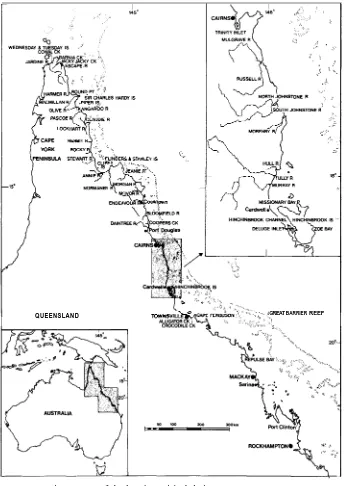
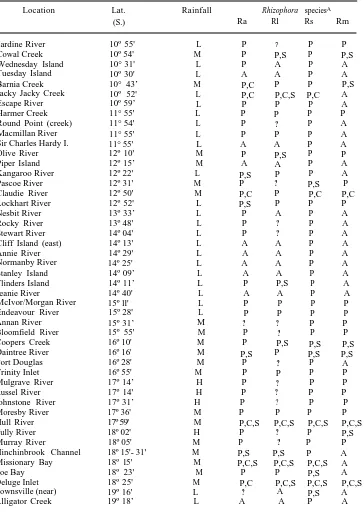

![Table 4. Mean measurements (cm) for Rhizophora species, with {range} and [number of componentsmeasured]](https://thumb-us.123doks.com/thumbv2/123dok_us/321523.64125/6.451.30.393.191.545/table-mean-measurements-rhizophora-species-range-number-componentsmeasured.webp)
